Skeet Shooting Fundamentals
These are excerpts from selected paragraphs in a condensed version of the Station-by-Station Analysis that will be available in Todd Bender"s soon to be published book on Skeet Shooting.
The following is the property of Todd Bender and toddbenderintl.com, and it is presented for educational and informational purposes only. Any use or reproduction of this article or any content on this website without the written consent of Todd Bender is prohibited.
Overview
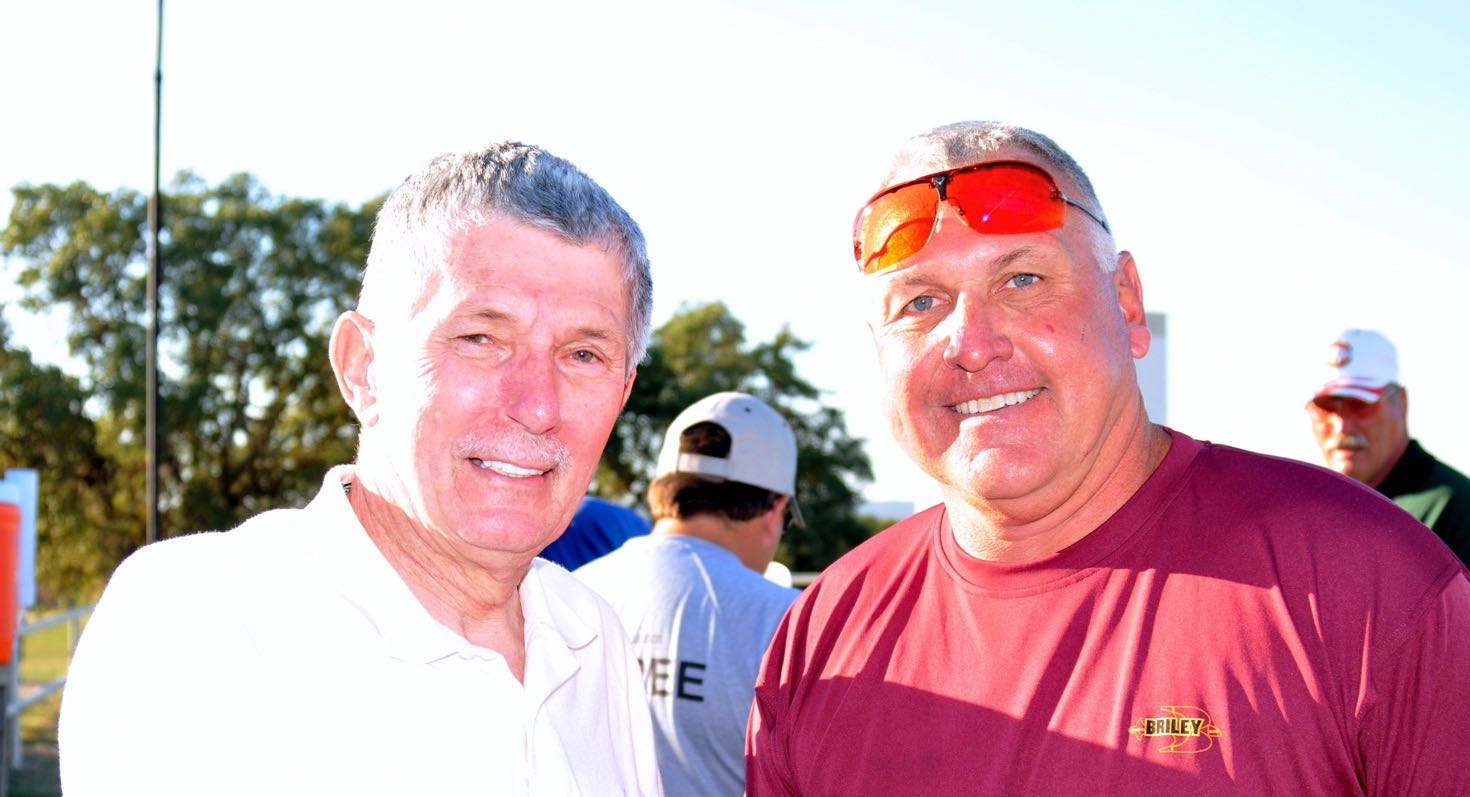
Shooters who have worked with me are well versed on my mantra, “head on the gun, eye on the target." This is because all shotgun shooting, be it American Skeet, Trap, Sporting Clays, and even field shooting, requires the three fundamentals, head on the gun, eye on the target, and proper lead, to be successful.
When shooting a shotgun, we must keep our heads firmly on the stock so that we see the correct relationship between the target and the barrel. The is the first of three the fundamentals. A shotgun has two sights, the front sight, which is the front bead on the barrel, and the rear sight, which is you. Much like the sights on an open-sighted rifle, as the rear sight is adjusted the impact point changes and the sights line up differently, slightly changing the direction the bullet travels. Raising the head off of the stock will cause the brain to “see" an improper relationship between the barrel and the target. As the brain immediately corrects this imbalance, it realigns the sights, usually resulting in a missed shot over the top.
Why over? Assuming a straight line from the rear sight, your eye, through the front sight to the target, as the head is lifted the alignment becomes non-linear. The eye will see the front sight as being below the target. Even though the gun is still aligned with the target, because the front sight has yet to move, the eye perceives this incongruity because of its new position. In realigning the sights, the muzzle is lifted, to bring the front sight back in line with the rear sight and the target. Although the brain “sees" the alignment as satisfactory again, in actuality the muzzle has been raised, as has the point of impact.
The second fundamental is keeping our eyes focused on the target so that the gun can move in concert with the target. Visual focus must be maintained on the target throughout the shot so that the brain receives a continuous flow of information regarding target speed, distance, elevation, and direction. Based on that information, our brain must then calculate the proper lead for the target and through action execute the shot.
We can better comprehend the act and the results of looking at the barrel through demonstration. Pick an object at distance, at least ten yards away, and focus on it. With your hand at your side, quickly point at the object. You should have no trouble doing this. We are all born with an innate ability to point, it is called hand-eye coordination. Now point your finger up in the sky and focus on the end of your finger. While continuing to focus on the end of your finger, lower your hand and point back at the selected object, but keep your focus on the end of your finger. You will find that this is much more difficult. As you look at the end of your finger, everything past that point is out of focus, including your target object, therefore it is difficult to find. The same thing happens when you look at the end of your gun barrel to check lead. Focus on the target is lost, undermining the whole process.
Notice that the act of pointing at the target was quite simple and rapid when focus was maintained on the object. Not once was there an inclination to look back at your finger to make sure that you were pointing at the object. This is because you are confident in your ability to point. Unfortunately we do not all have the same confidence in our abilities to point a shotgun, even though we should because it involves the same pointing attributes.
The act of pointing at a stationary object seems easy, but what if you have to lead that object. Let"s lead the object two feet to the right. Focus on the object and point two feet to the right. Again, the process should be simple. Now repeating, look at your finger and point two feet to the right of the object. Not as easy. So to facilitate pointing the shotgun and maintaining a relationship with a moving target, at distance, the eyes must continually have focus on the target.
The targeting system on a jet fighter works the same way. The system can lock onto a target, as long as the radar “sees" its intended victim. However, when contact on the target is lost, the system goes into neutral or back to actively searching, because it no longer has a target in “view" to track.
The third and final fundamental is to have the proper lead. Though important, lead is not nearly as influential to our success as the first two fundamentals, head on the stock, eye on the target. This is because we are shooting a shotgun, and a shotgun throws a big pattern. A normal skeet choke will throw a pattern that is close to thirty inches in diameter at twenty-one yards, the distance from any station to the center stake; also the distance that a majority of the shots are taken. So like hand-grenades, with a shotgun all you have to do is get close.
Let"s apply this thinking to an actual shot on the skeet field. Using High House, Station Five as an example, imagine shooting this shot, which requires approximately three to three and one-half feet of lead. You will notice that when I mention leads they will never be definite, but rather generalizations of the actual lead. If specific leads were given the tendency to be precise would be overwhelming, causing the eyes to look at the barrel in an effort to measure lead and be perfect.
But for demonstration"s sake, let"s pinpoint the lead for High Five at three and one-half feet, or forty–wo inches. Knowing that we are shooting a pattern, or more descriptively what the English refer to as a “shot cloud" that is twenty-six to thirty inches in diameter, if I put fifty inches of lead on High Five, am I likely to break it? Sure, I may be in front, but in all likelihood the target will break. If I shoot this shot with only thirty-two inches of lead, will it still break? More than likely the break would be off of the back of the target, due to the shortened lead.
What is important is that lead is not that important. As long as you are close, the shotgun will do the work. Your job as a shotgun shooter is to be a good rear sight of the shotgun. To do this, you need to do two things. First, keep the rear sight in the same place, maintaining alignment with the front sight and the target, head on the stock. Second, keep the rear sight looking at what it is trying to hit, eye on the target. Do these two things, and hand-eye coordination and the shotgun will do the rest.
If I have my head on the gun, and my eye on the target, and I give the target the proper lead, allowing time for my shot string to intercept the flight path of the target, I cannot miss. If my head is down properly on the stock, that gun will shoot where I look. If my eyes are focused on the target, I can then match gun speed with target speed and mirror the movements of the target. This mirroring of movements can only be achieved if I have focus on the target. Finally, if I give the target the proper lead for the given distance and angle of the shot, it is physically impossible for my shot string not to intercept the flight path of the target.
Using Body for Gun Movement
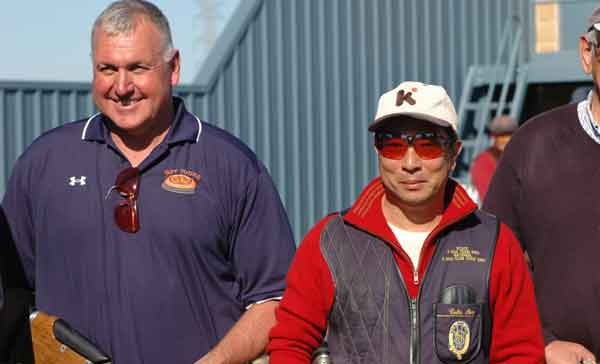
We can categorize shooter"s body movement by dividing them into two groups, upper body shooters and lower body shooters. Quite simply an upper body shooter uses the upper body to create gun movement and the lower body shooter relies on the legs to do the work. Let"s look at each more closely, and determine why one is better than the other.
First we will examine the movements of the upper body shooter. This shooter generates all of the gun movement from the waist up. To move the gun, the shoulders and arms push or really force the gun in the desired direction of the shot. A number of poor fundamentals are created when using the upper body to move the gun.
Initially, two bad things happen as the arms “push" the gun. First, using the arms to move the gun is a very limited move, you can try but you will find that you can only push the gun so far in either direction. Also, the arms push in a point A to point B fashion. This move is very linear, so it is difficult to rotate smoothly and match gun speed with target speed for any sustained period of time. Secondly, as the arms push or “throw" the gun to the target, the head will invariably come off the stock. Any upper body shooter who has a problem of “coming out of the gun", will continue to have that problem, regardless of how the problem is combated, until that shooter stops being an upper body shooter. Just the act of moving to the target, commences the pushing of the gun away from the face, which in essence, is raising the head.
While the arms are busy pushing the gun, the upper body follows the arm"s movement. Pushing back and forth from right to left, and left to right, the body"s weight shifts from on foot to the other. This happens because the arms have a limited area of movement, so the introduced weight shift increases the area covered by the push. As this weight shift occurs, you will notice that the shoulders do not stay level, but in fact roll as the body rocks back and forth. Now we"re in the quagmire, and deep.
Being a lower body shooter, all of the lateral rotation with the target is created by leg movement. It is the legs that do the turning. As discussed earlier, instead of right and left, our feet become front and back, the left foot is the front foot for the right handed shooter, the right foot for the left-hander. In order to counter the weight shift during the shot, I will position most of the body"s weight forward, onto the front foot.
This weight distribution can be easily demonstrated by standing with the feet underneath the shoulders, extending the fingers out from the left hand, and positioning yourself arm"s length away, and perpendicular to a wall, fingers just touching the wall. Left-handed shooters will extend the right arm. Now, while continuing to extend the arm, rotate the hand up, as if to tell the wall to “stop". Next, lean against the wall using the rotated hand as support. You will notice that a majority of your weight now is positioned on the foot closest to the wall. Now, drop your hand. Roughly eighty percent of your body weight is now on your “front" foot. This is the weight distribution that one would desire while using the lower body to shoot.
Maintaining, this position, turn to the right, then to the left, rotating over the front foot. Notice that the body turns smoothly, and of utmost importance, on one axis. I like to think of a pole extending up from the ground, through my left leg, and continuing up through the torso. This is the axis that I turn on, and it is an unbending axis.
As you turn from this position, take into account that it is the large quadricep muscles of the legs that are doing the turning, the upper body turns also, but it is just coming along for the ride. The shoulders remain in the same plane as the hips, following suit as the legs dictate the action.
Adopting this method of turning, we have essentially eliminated all of the problems experienced by the upper body shooter. Recognize that as we turn over the front foot, the shoulders stay level, thus eliminating a shoulder “roll". This roll only occurs when the weight shifts from the front to the back foot. Concurrently, as the weight remains over the front foot, balance is maintained throughout the shot.
Foot Position
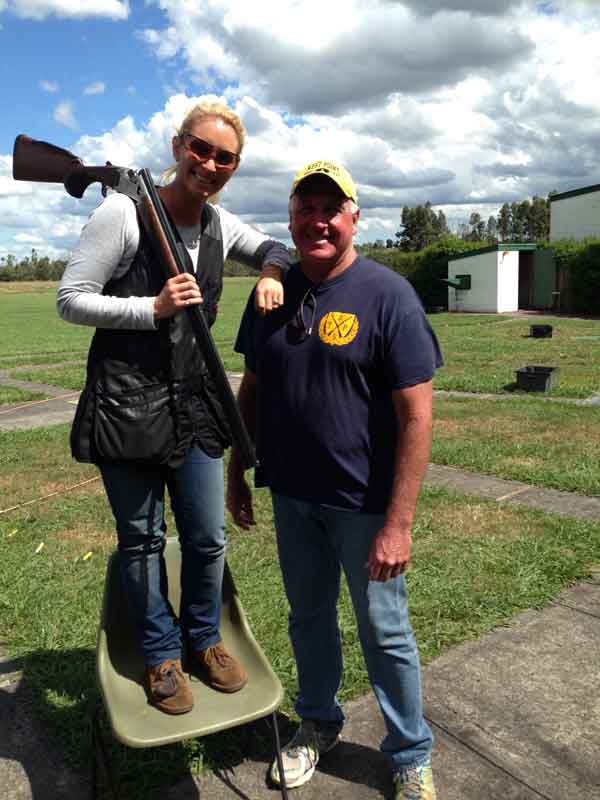
When shooting clay targets, our foot position dictates where we can and where we cannot move the shotgun with a reasonable amount of control. This is because it is the legs and body that actually move the shotgun. If it is the legs that do the work, then it is the feet that specify within which range the legs will work. We can easily demonstrate this. Stand up and place your feet shoulder width apart. Now turn to your left, then to your right. Observe that we can turn to our left only to a specific point where we bind up, and can turn no further. Conversely, there is corresponding limit to our turn to our right. Therefore, when shooting at moving targets, since the gun must move in a relative motion with the target, we would want to place the target, and target movement within our left to right turning limits, where our movement is uninterrupted. This thought is the basis for all foot positions on a skeet field.
Take note that above I mentioned that the feet should be placed underneath the shoulders. Your foot position relative to your body is also significant. While standing, place your feet shoulder width apart, and keep your feet parallel, as if you were wearing skis. Now turn. Remember to break the knees, that's why there is a joint in the middle of your leg, you are more flexible that way. With the knees locked, or legs straight, the joint is rendered useless. With your knees bent, your movement should be free and fluid. Now stagger your feet, one in front of the other, or point your toes outward, away from each other. Again turn, and notice that your ability to turn is noticeably hampered when the feet are not parallel, and or not in the same plane.
Foot position and the theory behind it is not brain surgery. In fact, if we accept the above discussion, then it is quite easy. Some shooters will argue its validity, but there is basically one foot position for the entire skeet field. For a right handed shooter, with two exceptions, your position for stations one through six, high house, low house, singles or doubles, is facing the low house window. For the left-handed shooter, stations two through seven, you will face the high house window. The exceptions are the locations on the field where you can"t possibly face the window. These shots would be Station Seven and High House, Station Eight for the right-shoulder shooter, and Station One and Low House Station Eight for the left-hand shooters. We will address these exceptions in a moment.
Obviously, this rule of facing the window seems rather simplistic. Nevertheless, it is based on solid facts. But how can one position work for most of the field? Understand that a skeet field is built around a semi-circle, and because of geometry, many of the shots and angles around the field of similar. Because many shots are the same, it stands to reason that many of our fundamentals on each shot, foot position, hold points, leads, will also be similar. So it follows logically that there could be a limited number of positions based on similarity of shots.
Hold Points
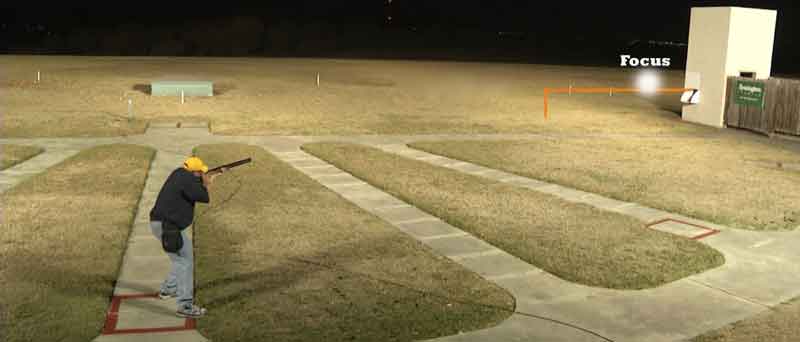
We will define a hold point, as a starting place for the gun, where movement is initiated on visual contact of the target. If this initial point is correct, then the ensuing movement of the gun with or to the target shall be simplified, and the desired lead will be become a by-product of the process, without effort. Therefore, the entire shot will be facilitated, because there will be no adjustments necessary in gun movement as lead is acquired, and most importantly, there will be less energy required by the shooter to execute that movement.
In actual application, this means that if I held my gun on the window of the house and called for a target, by the time that my brain visually acquires the target and sends impulses to the body to initiate movement, the target will be way ahead of me. It will have moved well toward the center of the field before I have had time to react. So, the ensuing gun movement to the target to obtain the necessary lead will be rushed, the gun will have to accelerate and over take the target, creating excessive gun movement to compensate for the poor or late start. This is the action of a swing through shooter. Conversely, a hold point that is too far away from the house requires the adjustment of slowing gun movement to let the target “catch up" with the gun. This movement basically involves stopping gun movement or “trapping the target", a movement which is undesirable for consistent shooting of a moving target.
Considering the above incorrect scenarios, we come to my definition of a “perfect" hold point. This is defined as a starting point for the gun, in which visual contact is made, and as gun movement is initiated, the shooter is allowed to match gun speed with target speed and immediately obtain the desired lead. The “perfect" hold point requires no accelerated or decelerated gun movement or adjustments to allow for required lead. As illustrated above, if my hold point is in “too close" to the house, or out “too far", either scenario requires adjustments in gun speed to allow for movement “with" the target, which is further defined as “matching gun speed with target speed." The concept of matching gun speed with target speed is the underlying principle and the defining gun movement for a sustained lead shooter.
When analyzing or calculating hold points, understand that they are dictated by one variable, and that is target speed. So any hold point that is mentioned in this text, is only a generalized starting point, that will be fine tuned for any given situation, or target speed.
My hold points will change slightly in direct proportion to the equivalent changes in target speed from club to club, or even from field to field. This means that a faster target will reach my hold point more quickly than normal, so that my hold points in that situation are moved away from the house to compensate for the extra speed. A slower target would take longer to reach my barrel at its initial start point, so my hold points are affected by moving more closely to the target origination point. These compensations are made to maintain an initial movement that immediately generates gun speed with target speed, and at the same time, generates a proper lead. Every shot that I approach on a skeet field involves planning that includes a precise hold point. Introducing the idea of the perfect hold point, we can deduce that different speed targets will require different hold points, to keep gun movement with the target consistent, without adjustments to obtain lead.
Hold points are usually measured from the starting point of target flight, the house or window, and defined by its placement and relationship within the boundaries of the field. Generally speaking, given my approach to the game, all shots on a skeet field can be initiated with a hold point that is “one third (1/3) of the way from the house you are shooting to the center stake." Let us take a High House – Station Four for example.
To properly set up for this target, my initial starting point would be one third of the way from the high house to the center stake. That distance, from high house to center stake, is 21 yards, so one third of the way would calculate to 21 feet out away from the high house. This distance from the house allows me time to see the target as it emerges from the window, initiate gun movement upon visual acquisition of the target, and with little effort, match gun speed with target speed, and obtain the proper lead with little effort. Although the distance “one third" of the way from the house you are shooting to the center stake is a generalization, in almost all cases it will get you in the “ballpark" to execute a facilitated sustained lead shot. Then, given the definition of a perfect hold point, your actually hold point can be altered to take into consideration the given target speed on that particular range.
Obtaining Lead
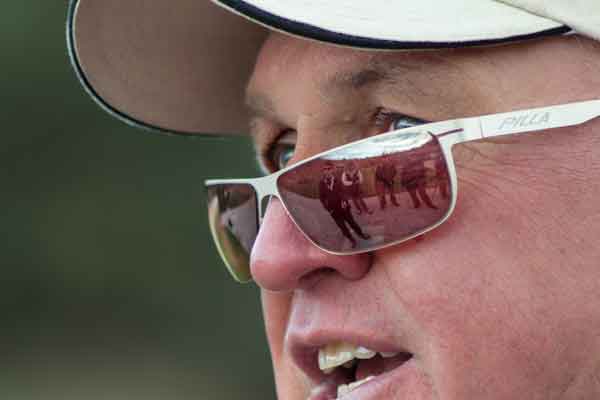
Although lead is the third of the three fundamentals required to hit a moving target with a shotgun, and even though the first two, head on the gun, eye on the target, are much more important to our conscious plan, lead is still a necessary ingredient to the mix.
There are three methods of obtaining and maintaining lead on a moving target. The first is the “swing through" method. This method first allows the target to move past the gun barrel. The target is then followed by the gun barrel and at a point just before the trigger is pulled, the gun accelerates past the target and the shot is fired. It is the acceleration of the gun through the target that generates the lead, hence, the swing through method.
A swing through shooter rarely sees much lead, if any at all. However, this is a perception. In most cases the trigger is pulled as the gun passes the target, the shooter perceives the gun pointing at the target. But given the accelerated gun speed used to catch and overcome the target, even if the gun is pointing at the target when the trigger is pulled, by the time the firing pin hits the primer, which ignites the powder, which sends the shot down the barrel, the accelerated gun now points ahead of the target, hopefully with the proper lead.
A swing through shooter will always say that they see very little lead. How could one shooter see four feet of lead on one shot, and another shooter claim that they see “no" lead on the identical target? We know that physically and mathematically that would be impossible given that the shooters fired similar speed ammunition on similar speed and distance targets. Using the above illustration, this discrepancy is because the swing through shooter sees a perceived lead, as opposed to the lead a shooter using a method that generates matched gun movement with target movement would see. That shooter would observe a “true" lead. The lead observed is true because that lead, assuming gun speed being matched with target speed, is the distance that the target will travel as the shot string moves to intercept the target"s flight.
Many field shooters, sporting clay shooters, and even skeet shooters employ this method. I find though this method lacks in application though, at least when one desires a consistent approach to skeet shooting. Examining the above scenario, everything is saved until the end, including and most importantly, the obtaining of the proper lead. In fact, the shooter is never “on" the target, until the trigger is pulled.
The second means of obtaining lead is the “pull ahead" method. This way of obtaining lead is the chosen method of England"s Clay Pigeon Shooting Association (CPSA). In fact, in England it is referred to as “the Method". When shooting “pull ahead", after the target appears, the gun is pointed at the target throughout the shot, until the time to shoot the target, then the gun “pulls" ahead, obtaining the necessary lead, and the shot is taken.
This method has many advantages, the first of which satisfies one of the more difficult aspects of shotgunning. No matter what the target, round and made out of clay, or feathered, the most difficult variable to master on each shot is the determination of target direction, speed, angle, and elevation. Simply by point at the target, and then continuing to do so, all of the above variables are determined. By mirroring the target"s movement, or as the English would say, “moving in empathy with the target", the target"s direction, speed, angle, and elevation are automatically calculated. All that is left is the introduction of the proper lead.
The third method of obtaining lead is the “sustained lead" method. This is my choice, and the most widely accepted method in the game of skeet. This method matches gun speed with target speed, much in the same way that the “pull ahead" method did, but at all times, we are ahead of the target, sustaining or maintaining the proper lead as we move the gun, forcing the target to follow the barrel. Any shot execution discussed in this book will implement the sustained lead method. This method also allows me to see a truer lead for a longer period of time, as discussed previously in the above paragraphs.
During any one of my well executed shots, I will immediately, upon the target emerging from the window, match gun speed with target speed, establish a lead, and then “carry" the target to my desired break point. By setting up the target, gun speed and lead, as early as possible, I control the shot, being able to first, break the target at my desired point, and secondly, I do not have to wait until the last possible moment to obtain a lead. Imagine that on every shot I attempt, that after the target has traveled no more that twenty feet from the house, I have matched gun speed with target speed and have already obtained the proper lead. Having done that on every shot, how many targets am I going to hit?
Shooting a sustained lead means that the target never gets in front of the gun. Most shooters accept that when a target “beats" them, the target gets ahead of their barrel. In my mind, a target “beats" me when it gets any closer to my barrel than the lead I am looking for. Example, if High Three requires three feet of lead, then High Three never gets any closer to my barrel than three feet, nor does it get much further away than three feet. This is the essence of sustained lead, total and constant control of the target.
Sustained lead on a target is the most consistent and most controlled way of approaching targets on a skeet field. Since all the shots on a skeet field are “known" or “givens", this method allows us to control targets immediately, manipulating the shot placement to our advantage.
Go to the “Station by Station Analysis" Section for application of these fundamentals to skeet shooting.
